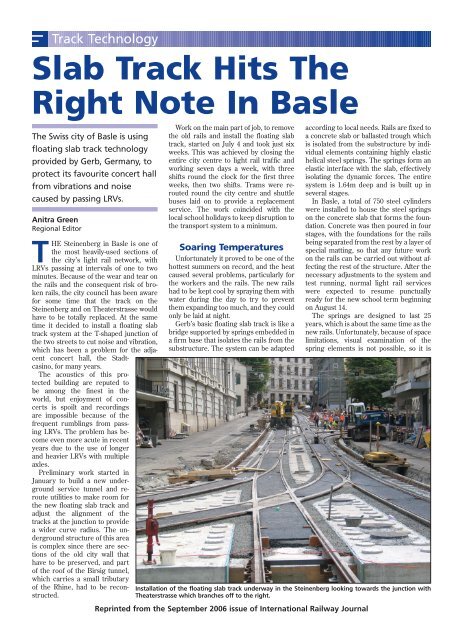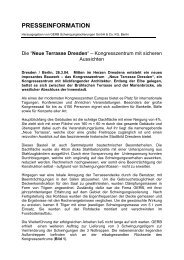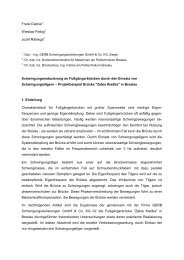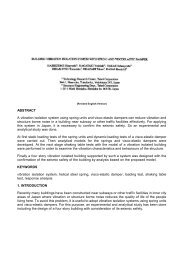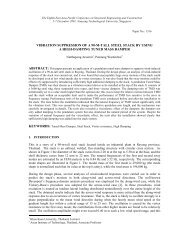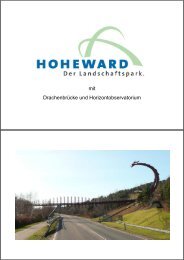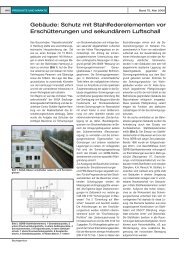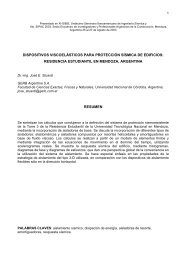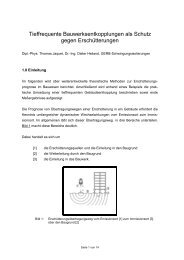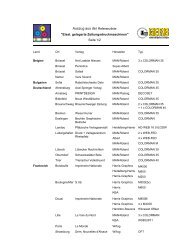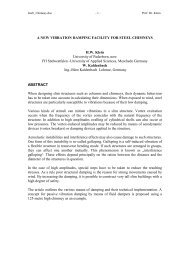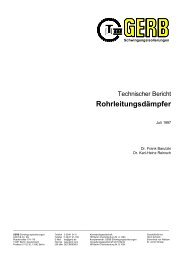Create successful ePaper yourself
Turn your PDF publications into a flip-book with our unique Google optimized e-Paper software.
Gerb 31/10/06 09:19 Page 97<br />
<strong>Track</strong> Technology<br />
<strong>Slab</strong> <strong>Track</strong> <strong>Hits</strong> <strong>The</strong><br />
<strong>Right</strong> <strong>Note</strong> <strong>In</strong> <strong>Basle</strong><br />
<strong>The</strong> Swiss city of <strong>Basle</strong> is using<br />
floating slab track technology<br />
provided by Gerb, Germany, to<br />
protect its favourite concert hall<br />
from vibrations and noise<br />
caused by passing LRVs.<br />
Anitra Green<br />
Regional Editor<br />
THE Steinenberg in <strong>Basle</strong> is one of<br />
the most heavily-used sections of<br />
the city’s light rail network, with<br />
LRVs passing at intervals of one to two<br />
minutes. Because of the wear and tear on<br />
the rails and the consequent risk of broken<br />
rails, the city council has been aware<br />
for some time that the track on the<br />
Steinenberg and on <strong>The</strong>aterstrasse would<br />
have to be totally replaced. At the same<br />
time it decided to install a floating slab<br />
track system at the T-shaped junction of<br />
the two streets to cut noise and vibration,<br />
which has been a problem for the adjacent<br />
concert hall, the Stadtcasino,<br />
for many years.<br />
<strong>The</strong> acoustics of this protected<br />
building are reputed to<br />
be among the finest in the<br />
world, but enjoyment of concerts<br />
is spoilt and recordings<br />
are impossible because of the<br />
frequent rumblings from passing<br />
LRVs. <strong>The</strong> problem has become<br />
even more acute in recent<br />
years due to the use of longer<br />
and heavier LRVs with multiple<br />
axles.<br />
Preliminary work started in<br />
January to build a new underground<br />
service tunnel and reroute<br />
utilities to make room for<br />
the new floating slab track and<br />
adjust the alignment of the<br />
tracks at the junction to provide<br />
a wider curve radius. <strong>The</strong> underground<br />
structure of this area<br />
is complex since there are sections<br />
of the old city wall that<br />
have to be preserved, and part<br />
of the roof of the Birsig tunnel,<br />
which carries a small tributary<br />
of the Rhine, had to be reconstructed.<br />
Work on the main part of job, to remove<br />
the old rails and install the floating slab<br />
track, started on July 4 and took just six<br />
weeks. This was achieved by closing the<br />
entire city centre to light rail traffic and<br />
working seven days a week, with three<br />
shifts round the clock for the first three<br />
weeks, then two shifts. Trams were rerouted<br />
round the city centre and shuttle<br />
buses laid on to provide a replacement<br />
service. <strong>The</strong> work coincided with the<br />
local school holidays to keep disruption to<br />
the transport system to a minimum.<br />
Soaring Temperatures<br />
Unfortunately it proved to be one of the<br />
hottest summers on record, and the heat<br />
caused several problems, particularly for<br />
the workers and the rails. <strong>The</strong> new rails<br />
had to be kept cool by spraying them with<br />
water during the day to try to prevent<br />
them expanding too much, and they could<br />
only be laid at night.<br />
Gerb’s basic floating slab track is like a<br />
bridge supported by springs embedded in<br />
a firm base that isolates the rails from the<br />
substructure. <strong>The</strong> system can be adapted<br />
according to local needs. Rails are fixed to<br />
a concrete slab or ballasted trough which<br />
is isolated from the substructure by individual<br />
elements containing highly elastic<br />
helical steel springs. <strong>The</strong> springs form an<br />
elastic interface with the slab, effectively<br />
isolating the dynamic forces. <strong>The</strong> entire<br />
system is 1.64m deep and is built up in<br />
several stages.<br />
<strong>In</strong> <strong>Basle</strong>, a total of 750 steel cylinders<br />
were installed to house the steel springs<br />
on the concrete slab that forms the foundation.<br />
Concrete was then poured in four<br />
stages, with the foundations for the rails<br />
being separated from the rest by a layer of<br />
special matting, so that any future work<br />
on the rails can be carried out without affecting<br />
the rest of the structure. After the<br />
necessary adjustments to the system and<br />
test running, normal light rail services<br />
were expected to resume punctually<br />
ready for the new school term beginning<br />
on August 14.<br />
<strong>The</strong> springs are designed to last 25<br />
years, which is about the same time as the<br />
new rails. Unfortunately, because of space<br />
limitations, visual examination of the<br />
spring elements is not possible, so it is<br />
<strong>In</strong>stallation of the floating slab track underway in the Steinenberg looking towards the junction with<br />
<strong>The</strong>aterstrasse which branches off to the right.<br />
Reprinted from the September 2006 issue of <strong>In</strong>ternational Railway Journal
Gerb 31/10/06 09:19 Page 98<br />
Flat elastomer<br />
sealing strip<br />
Surfacing<br />
Hot mixed<br />
aggregates<br />
<strong>Track</strong> Technology<br />
Filler stabilised<br />
with concrete<br />
Wall element<br />
prefabricated<br />
Poured on site<br />
(connecting<br />
reinforcement out<br />
of base plates)<br />
proposed to dismantle some of them from<br />
time to time to monitor their efficiency.<br />
With these measures, the noise in the<br />
concert hall should be reduced by 20-<br />
25dB, which will bring it down to a level<br />
experts say is acceptable. <strong>The</strong> previous<br />
level was around 46dB. <strong>The</strong> authorities in<br />
<strong>Basle</strong> selected this option as being the<br />
Spring elements<br />
cross-section<br />
Asphalt<br />
GERB spring elements<br />
GSI -R2<br />
GERB’S FLOATING SLAB TRACK<br />
Air shaft<br />
Foil as separating layer<br />
best system available today. <strong>The</strong> alternative<br />
would have been a simpler system<br />
only 900mm deep, which although<br />
cheaper would only have reduced noise<br />
levels by 10 to 15dB.<br />
<strong>Basle</strong> city council approved expenditure<br />
of SFr 11.8 million ($US 9.7 million)<br />
for the project. Of this, SFr 4.7 million was<br />
Rail chairs and recesses<br />
cross-section<br />
for preliminary work on the Steinenberg,<br />
and SFr 7.1 million for the installation of<br />
the floating slab track. Another SFr 8 million<br />
is being spent on related works. SFr 3<br />
million is being contributed by a speciallyformed<br />
private foundation. <strong>The</strong> entire<br />
project is scheduled for completion by<br />
February 2007. IRJ<br />
Reprinted from the September 2006 issue of <strong>In</strong>ternational Railway Journal<br />
Air shaft


